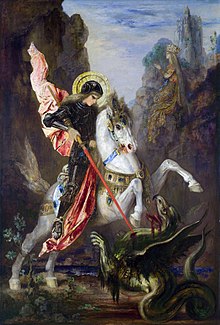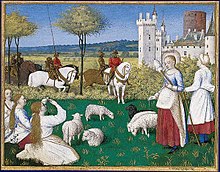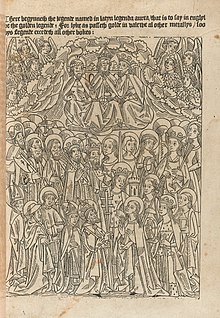Golden Legend
From Wikipedia, the free encyclopedia
encyclopedia
 encyclopedia
encyclopedia
For the Arthur Sullivan cantata, see The Golden Legend (cantata).

The story of Saint George and the dragon is one of many stories of the saints preserved in the Golden Legend.
Contents
[hide]A medieval bestseller[edit]
Initially entitled Legenda sanctorum (Readings of the Saints), it gained its popularity under the title by which it is best known. It overtook and eclipsed earlier compilations of abridged legendaria, the Abbreviatio in gestis et miraculis sanctorum attributed to the Dominican chronicler Jean de Mailly and the Epilogus in gestis sanctorum of the Dominican preacher Bartholomew of Trent. Over eight hundred[3] manuscript copies of the work survive, and when printing was invented in the 1450s, editions appeared quickly, not only in Latin, but also in every major European language. Among incunabula, printed before 1501, Legenda aurea was printed in more editions than the Bible.[4] It was one of the first books William Caxton printed in the English language; Caxton's version appeared in 1483 and his translation was reprinted, reaching a ninth edition in 1527. In 1900, the Caxton version was translated by Frederick Startridge Ellis, and published in seven volumes. De Voragine's original was translated into French around the same time by Téodor de Wyzewa.[5]
was reprinted, reaching a ninth edition in 1527. In 1900, the Caxton version was translated by Frederick Startridge Ellis, and published in seven volumes. De Voragine's original was translated into French around the same time by Téodor de Wyzewa.[5]Fanciful etymologies[edit]
The book sought to compile traditional lore about all of the saints venerated at the time of its compilation. Jacobus de Voragine typically begins with an (often fanciful) etymology for the saint's name. An example (in Caxton's translation) shows his method:- Silvester is said of sile or sol which is light, and of terra the earth, as who saith the light of the earth, that is of the church. Or Silvester is said of silvas and of trahens, that is to say he was drawing wild men and hard unto the faith. Or as it is said in glossario, Silvester is to say green, that is to wit, green in contemplation of heavenly things, and a toiler in labouring himself; he was umbrous or shadowous. That is to say he was cold and refrigate from all concupiscence of the flesh, full of boughs among the trees of heaven.[6]
Lives of the saints[edit]

Saint Margaret attracts the attention of the Roman prefect, by Jean Fouquet from an illuminated manuscript
Sources[edit]

The life of St. Barbara, a virgin who turned to Christianity against the will of her pagan father, is mostly known from the Golden Legend.[7] The Walters Art Museum.
- In this time it happed that there was at Rome a dragon in a pit, which every day slew with his breath more than three hundred men. Then came the bishops of the idols unto the emperor and said unto him: O thou most holy emperor, sith the time that thou hast received Christian faith the dragon which is in yonder fosse or pit slayeth every day with his breath more than three hundred men. Then sent the emperor for S. Silvester and asked counsel of him of this matter. S. Silvester answered that by the might of God he promised to make him cease of his hurt and blessure of this people. Then S Silvester put himself to prayer, and S. Peter appeared to him and said: "Go surely to the dragon and the two priests that be with thee take in thy company, and when thou shalt come to him thou shalt say to him in this manner: Our Lord Jesu Christ which was born of the Virgin Mary, crucified, buried and arose, and now sitteth on the right side of the Father, this is he that shall come to deem and judge the living and the dead, I commend thee Sathanas that thou abide him in this place till he come. Then thou shalt bind his mouth with a thread, and seal it with thy seal , wherein is the imprint of the cross. Then thou and the two priests shall come to me whole and safe, and such bread as I shall make ready for you ye shall eat."
- Thus as S. Peter had said, S. Silvester did. And when he came to the pit, he descended down one hundred and fifty steps, bearing with him two lanterns, and found the dragon, and said the words that S. Peter had said to him, and bound his mouth with the thread, and sealed it, and after returned, and as he came upward again he met with two enchanters which followed him for to see if he descended, which were almost dead of the stench of the dragon, whom he brought with him whole and sound, which anon were baptized, with a great multitude of people with them. Thus was the city of Rome delivered from double death, that was from the culture and worshipping of false idols, and from the venom of the dragon.[10]
Miracle tales of relics[edit]
Many of the stories also conclude with miracle tales and similar wonderlore from accounts of those who called upon that saint for aid or used the saint's relics. Such a tale is told of Saint Agatha; Jacobus de Voragine has pagans in Catania repairing to the relics of St. Agatha to supernaturally repel an eruption of Mount Etna:- "And for to prove that she had prayed for the salvation of the country, at the beginning of February, the year after her martyrdom, there arose a great fire, and came from the mountain toward the city of Catania and burnt the earth and stones, it was so fervent. Then ran the paynims to the sepulchre of S. Agatha and took the cloth that lay upon her tomb, and held it abroad against the fire, and anon on the ninth day after, which was the day of her feast, ceased the fire as soon as it came to the cloth that they brought from her tomb, showing that our Lord kept the city from the said fire by the merits of S. Agatha."[11]
16th-century collapse[edit]
The adverse reaction to Legenda aurea under critical scrutiny in the 16th century was led by scholars who reexamined the criteria for judging hagiographic sources and found Legenda aurea wanting; prominent among the humanists were two disciples of Erasmus, Georg Witzel, in the preface to his Hagiologium, and Juan Luis Vives in De disciplinis. Criticism among members of Jacobus' Dominican order were muted by the increased reverence towards the archbishop, which culminated in his canonization in 1815. The rehabilitation of Legenda aurea in the 20th century, now interpreted as a mirror of the heartfelt pieties of the 13th, is attributed[12] to Téodor de Wyzewa, whose retranslation into French, and its preface, have been often reprinted.Value to students of medieval culture[edit]
The critical edition of the Latin text has been edited by Giovanni Paolo Maggioni (Florence: SISMEL 1998).
A modern English translation of the Golden Legend has been published by William Granger Ryan, ISBN 0-691-00153-7 and ISBN 0-691-00154-5 (2 volumes).
A modern translation of the Golden Legend is available from Fordham University's Medieval Sourcebook.[13]
See also[edit]
References[edit]
- Jump up ^ Hilary Maddocks, "Pictures for aristocrats: the manuscripts of the Légende dorée", in Margaret M. Manion, Bernard James Muir, eds. Medieval texts and images: studies of manuscripts from the Middle Ages 1991:2; a study of the systemization of the Latin manuscripts of the Legenda aurea is B. Fleith, "Le classement des quelque 1000 manuscrits de la Legenda aurea latine en vue de l'éstablissement d'une histoire de la tradition" in Brenda Dunn-Lardeau, ed. Legenda Aurea: sept siècles de diffusion", 1986:19-24
- Jump up ^ An introduction to the Legenda, its great popular late medieval success and the collapse of its reputation in the 16th century, is Sherry L. Reames, The Legenda Aurea: a reexamination of its paradoxical history, University of Wisconsin, 1985.
- Jump up ^ Number supplied by Reames 1985:4.
- Jump up ^ Reames 1985.
- Jump up ^ Jacobus (de Vorágine) (1973). The Golden Legend. CUP Archive. pp. 8–. GGKEY:DE1HSY5K6AF. Retrieved 16 November 2012.
- Jump up ^ "The Life of St. Sylvester." The Golden Legend or Lives of the Saints. Compiled by Jacobus de Voraigne. Trans. William Caxton. Ed. F. S. Ellis. Reproduced at www.Aug.edu/augusta/iconography/goldenLegend, Augusta State University.
- Jump up ^ "St Barbara Directing the Construction of a Third Window in Her Tower". The Walters Art Museum.
- Jump up ^ Hilary Maddocks, "Pictures for aristocrats: the manuscripts of the Légende dorée", in Margaret M. Manion and Bernard James Muir, eds.,Medieval Texts and Images: studies of manuscripts from the Middle Ages 1991:2 note 4.
- Jump up ^ Christopher Stace, tr., The Golden Legend: selections' (Penguin), "Introduction" pp xii-xvi, reporting conclusions of K. Ernest Geith, (Geith, "Jacques de Voragine, auteur indépendant ou compilateur?" in Brenda Dunn-Lardeau, ed. Legenda aurea - 'La Légende dorée 1993:17-32) who printed the comparable texts side by side.
- Jump up ^ "The Life of St. Sylvester." The Golden Legend or Lives of the Saints. Compiled by Jacobus de Voraigne. Trans. William Caxton. Ed. F. S. Ellis. London: Temple Classics, 1900. Reproduced at www.Aug.edu/augusta/iconography/goldenLegend, Augusta State University.
- Jump up ^ "The Life of St. Agatha." The Golden Legend or Lives of the Saints. Compiled by Jacobus de Voraigne. Trans. William Caxton. Ed. F. S. Ellis. London: Temple Classics, 1900. Reproduced at www.Aug.edu/augusta/iconography/goldenLegend, Augusta State University.
- Jump up ^ Reames 1985:18ff.
- Jump up ^ The Golden Legend. Compiled by Jacobus de Voraigne. Trans. William Caxton. Ed. F. S. Ellis. London: Temple Classics, 1900. Reproduced in Medieval Sourcebook, Fordham University: http://www.fordham.edu/halsall/basis/goldenlegend
External links[edit]
| Wikimedia Commons has media related to Golden Legend. |
- The Golden Legend — William Caxton's Middle English version (not quite complete).
- Wikisource text with missing page from St. Paul supplied.
- The Golden Legend — Caxton's version, formatted for easy reading (HTML and PDF).
 "Legends of the Saints". Catholic Encyclopedia. New York: Robert Appleton Company. 1913.
"Legends of the Saints". Catholic Encyclopedia. New York: Robert Appleton Company. 1913.- Illustrations of The Golden Legend from the HM 3027 manuscript of Legenda Aurea from the Huntington Library
- William Caxton's version (complete).




